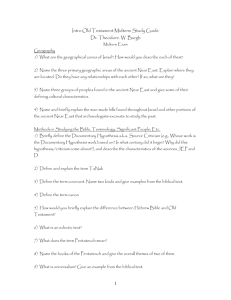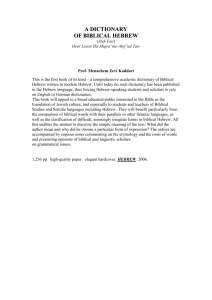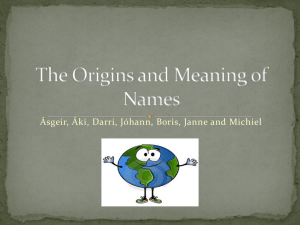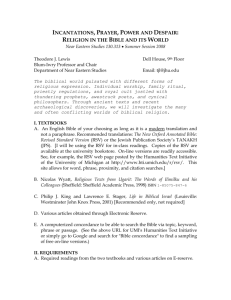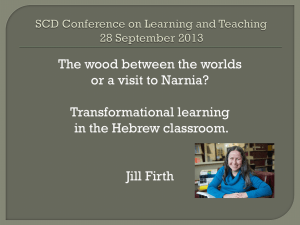ancient place names in israel
advertisement
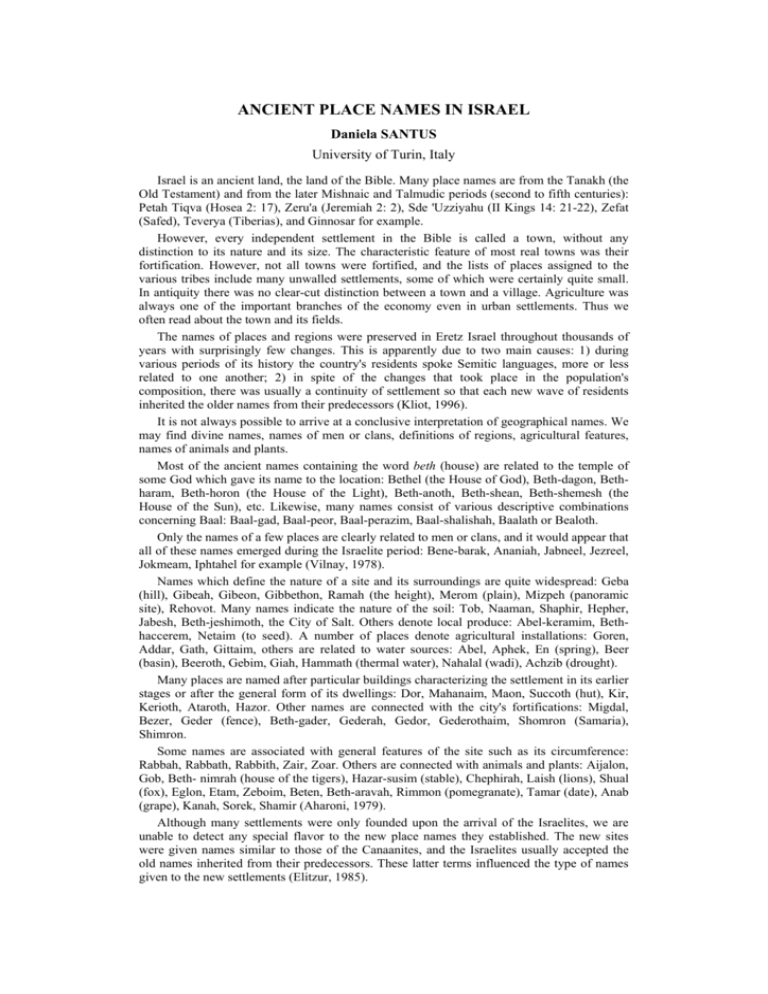
ANCIENT PLACE NAMES IN ISRAEL Daniela SANTUS University of Turin, Italy Israel is an ancient land, the land of the Bible. Many place names are from the Tanakh (the Old Testament) and from the later Mishnaic and Talmudic periods (second to fifth centuries): Petah Tiqva (Hosea 2: 17), Zeru'a (Jeremiah 2: 2), Sde 'Uzziyahu (II Kings 14: 21-22), Zefat (Safed), Teverya (Tiberias), and Ginnosar for example. However, every independent settlement in the Bible is called a town, without any distinction to its nature and its size. The characteristic feature of most real towns was their fortification. However, not all towns were fortified, and the lists of places assigned to the various tribes include many unwalled settlements, some of which were certainly quite small. In antiquity there was no clear-cut distinction between a town and a village. Agriculture was always one of the important branches of the economy even in urban settlements. Thus we often read about the town and its fields. The names of places and regions were preserved in Eretz Israel throughout thousands of years with surprisingly few changes. This is apparently due to two main causes: 1) during various periods of its history the country's residents spoke Semitic languages, more or less related to one another; 2) in spite of the changes that took place in the population's composition, there was usually a continuity of settlement so that each new wave of residents inherited the older names from their predecessors (Kliot, 1996). It is not always possible to arrive at a conclusive interpretation of geographical names. We may find divine names, names of men or clans, definitions of regions, agricultural features, names of animals and plants. Most of the ancient names containing the word beth (house) are related to the temple of some God which gave its name to the location: Bethel (the House of God), Beth-dagon, Bethharam, Beth-horon (the House of the Light), Beth-anoth, Beth-shean, Beth-shemesh (the House of the Sun), etc. Likewise, many names consist of various descriptive combinations concerning Baal: Baal-gad, Baal-peor, Baal-perazim, Baal-shalishah, Baalath or Bealoth. Only the names of a few places are clearly related to men or clans, and it would appear that all of these names emerged during the Israelite period: Bene-barak, Ananiah, Jabneel, Jezreel, Jokmeam, Iphtahel for example (Vilnay, 1978). Names which define the nature of a site and its surroundings are quite widespread: Geba (hill), Gibeah, Gibeon, Gibbethon, Ramah (the height), Merom (plain), Mizpeh (panoramic site), Rehovot. Many names indicate the nature of the soil: Tob, Naaman, Shaphir, Hepher, Jabesh, Beth-jeshimoth, the City of Salt. Others denote local produce: Abel-keramim, Bethhaccerem, Netaim (to seed). A number of places denote agricultural installations: Goren, Addar, Gath, Gittaim, others are related to water sources: Abel, Aphek, En (spring), Beer (basin), Beeroth, Gebim, Giah, Hammath (thermal water), Nahalal (wadi), Achzib (drought). Many places are named after particular buildings characterizing the settlement in its earlier stages or after the general form of its dwellings: Dor, Mahanaim, Maon, Succoth (hut), Kir, Kerioth, Ataroth, Hazor. Other names are connected with the city's fortifications: Migdal, Bezer, Geder (fence), Beth-gader, Gederah, Gedor, Gederothaim, Shomron (Samaria), Shimron. Some names are associated with general features of the site such as its circumference: Rabbah, Rabbath, Rabbith, Zair, Zoar. Others are connected with animals and plants: Aijalon, Gob, Beth- nimrah (house of the tigers), Hazar-susim (stable), Chephirah, Laish (lions), Shual (fox), Eglon, Etam, Zeboim, Beten, Beth-aravah, Rimmon (pomegranate), Tamar (date), Anab (grape), Kanah, Sorek, Shamir (Aharoni, 1979). Although many settlements were only founded upon the arrival of the Israelites, we are unable to detect any special flavor to the new place names they established. The new sites were given names similar to those of the Canaanites, and the Israelites usually accepted the old names inherited from their predecessors. These latter terms influenced the type of names given to the new settlements (Elitzur, 1985). Instances of changing the former name by the Israelites are quite rare. The only certain example is Canaanite Laish (Leshem) which was called Dan after the tribe which conquered and occupied it (Judg. 18: 29). Even in cases of intentional change, such as that of Kenath in Bashan, which was captured by Noah and named after him (Num. 32: 42), or of the Edomite Sela, which was called Joktheel after its submission to Amaziah (2 Kings 14: 17), the new names were unsuccessful in supplanting the old. The biblical sources have undergone a long process of oral and written transmission and it is clear that, in spite of the great care taken in transmitting the biblical text, some errors with regard to place names have crept in. This is especially true of places mentioned only once or twice in the Bible. Sometimes it is possible to trace the errors in biblical place names, particularly in those instances where several copies of the same list are preserved. As an example, the towns of Simeon are listed in Joshua 19: 2-8; 1 Chronicles 4: 28-33; and Joshua 15: 26-32; while a few of them also appear in Nehemiah 11: 25-29 and 1 Samuel 30: 27-30. Comparison of these lists reveals that errors and changes have taken place in some of the names, especially those known only from these same texts. Towns like Beer Sheva, Hormah and Ziklag appear in all the lists without change. A few names can be explained as variants of one another: Hazar-susah (Josh. 19: 5) and Hazar-susim (1 Chron. 4: 31), Beth-lebaoth (Josh. 19: 6) and Lebaoth (Josh. 15: 32), and also Eltolad (Josh. 15: 30; 19: 4) and Tolad (1 Chron. 4: 29). However, other names are errors for one original form: Baalah (Josh. 15: 29), Balah (Josh. 19: 3), Bilhah (1 Chron. 4: 29) in which instance scholars are unable to determine the original form with any certainty (Aharoni, 1979). Many of the ancient place names have been preserved among the local residents up to the present time, in spite of all the historical convulsions and population changes that have taken place. The biblical town of Ashdod became the Arab town of Isdud before becoming again Ashdod, for example. The following table is illustrative: ANCIENT NAME MODERN ARAB NAME MODERN HEBREW NAME Abdon Kh. 'Abdeh Avdon Acco el-Fukhkhar Akko Arad Arad Arad Beer-Sheba es-Seba Beer-Sheva Bene-berak Ibn Ibraq Bene-beraq Beten Ibtin Ivtan Bethlehem Beit Lahm Bet Lehem En Gedi 'Ain Jidi En Gedi Eshtaol Ishwa Eshtaol Gaza Ghazzeh Gaza Gezer Jezer Gezer Hadid el-Haditheh Hadid Jehud el-Yehudiyeh Yehud Jerusalem el-Quds Jerusalem Lod el-Ludd Lod Megiddo el-Mutesellim Megiddo Shikimonah es-Samak Shiqmona Zanoah Kh. Zanu Zanoah Zorah Sar'ah Zora 132 Of course most place names have been subjected to certain phonetic and linguistic processes during the course of their transmission. Biblical Hebrew was very close to the Canaanite language that had prevailed in Eretz Israel before it. But from the Persian through the Roman periods Aramaic was used, and after the Islamic conquest even this latter was displaced by Arabic (Soffer, 1978). Many names underwent modifications as a result of these changes in the spoken language. Frequently a Hebrew element was replaced by a similar Arabic word which might have the same meaning or might be a result of folk etymology: the Hebrew Beth-shemesh (the House of the Sun) became the Arabic 'Ain Shems (the Eye of the Sun); but the Hebrew Beth-horon (the House of the Light) became the Arabic Beit 'Ur (the House of the Blind). Not every name, of course, has been preserved. There are 350 localities, out of 770 Jewish localities within the 1967 borders (and 36% of the 174 Jewish localities established in the administered territories in the post 1967 period), with Biblical, Mishnaic and Talmudic names. One-fourth of the 584 Arab localities in Israel and the Territories have ancient Biblical names too: Sakhnin, for example, was a Jewish town during the Talmudic era, and Beit Lehem is the Biblical city of Bethlehem. But 59 localities, or 6,6% of the pre-1967 Israel Jewish localities, have names of Arabic origin, and 15 of the 174 Jewish localities founded in the Territories have names of Arabic origin too (Cohen, Kliot, 1992). There are cases where the ancient name has been transferred to a nearby location. Out of approximately 475 place names mentioned in the Bible only about 262 have been identified with any degree of certainty. 190 of these are based upon preservation of the name (40% of the total), of which 158 (33%) are places still bearing the name, and 32 (6,7%) where the name was found somewhere in the vicinity of the ancient site (Sarel, 1988). Place names are symbols that carry meaningful messages, and nowadays Biblical names sustain the link between the Jews and Ha'Aretz (the Land): the larger share of Biblical names in the Territories is due to government policy; the ideological zeal of the settlers; and the fact that Judea and Samaria were the heartland of ancient Israel (Kliot, 1996). For Israeli Jews, place names are part of the mechanism of landscape transformation and nation-building. REFERENCES Aharoni Y., 1979, The Land of the Bible. A Historical Geography, London, Burns & Oates. Cohen S. B. and Kliot N., 1992, “Place names in Israel's ideological struggle over the administered territories”, Annals of the Association of American Geographers, n. 82, pp. 653680. Elitzur Y., 1985, “The territorial concept in the Arab village and in Biblical geography”, Erlich Z. (ed.), Before Ephraim, Benyamin and Menashe, Jerusalem, Ofra Field School. Kliot, N., 1996, “Place names, culture, and politics”, Gradus Y. and Lipshitz G., (eds.), The Mosaic of Israeli Geography, Jerusalem, Ben Gurion University of the Negev Press, pp. 247252. Sarel B., 1988, Israel sites and places, Tel Aviv, Carta. Soffer A., 1978, “Geographical terms in names of Arab villages in Israel”, Teva Va'aretz, n. 21, pp. 4-9 (Hebrew). Vilnay, Z., 1978, Ariel encyclopedia of settlements in Eretz Israel, (3 v.), Tel Aviv, Am Oved, (Hebrew). 133
